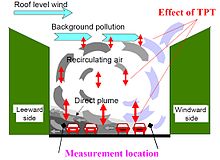- Operational Street Pollution Model
-
The Operational Street Pollution Model (OSPM) is an atmospheric dispersion model for simulating the dispersion of air pollutants in so-called street canyons. It was developed by the National Environmental Research Institute of Denmark, Department of Atmospheric Environment. For about 20 years, OSPM has been used in many countries for studying traffic pollution, performing analyses of field campaign measurements, studying efficiency of pollution abatement strategies, carrying out exposure assessments and as reference in comparisons to other models. OSPM is generally considered as state-of-the-art in practical street pollution modelling.
Contents
Description
In OSPM concentrations of traffic-emitted pollution is calculated using a combination of a plume model for the direct contribution and a box model for the recirculating part of the pollutants in the street.
The NO2 concentrations are calculated taking into account NO-NO2-O3 chemistry and the residence time of pollutants in the street. The model is designed to work with input and output in the form of one-hour averages.
The main principles in the model are depicted in Figure 1 for the case of a wind direction nearly perpendicular to the street canyon. A receptor point in leeward position is affected by the direct plume showing considerably higher concentrations than a receptor in windward position being exposed to the less concentrated recirculating air.
The turbulence produced by the moving traffic (TPT) is acting in addition to the turbulence created by the roof level wind. This leads to a faster dispersion of the direct plume but also to an improved air exchange at roof level between the street canyon and the background air.
See also
Further reading
For those who are unfamiliar with air pollution dispersion modelling and would like to learn more about the subject, it is suggested that either one of the following books be read:
- Turner, D.B. (1994). Workbook of atmospheric dispersion estimates: an introduction to dispersion modeling (2nd Edition ed.). CRC Press. ISBN 1-56670-023-X. www.crcpress.com
References
Atmospheric, oceanographic and climate models Model types Specific models ClimateGlobal weatherRegional and mesoscale atmosphericRegional and mesoscale oceanographicHyCOM · ROMSAtmospheric dispersionNAME · MEMO · OSPM · ADMS 3 · ATSTEP · AUSTAL2000 · CALPUFF · DISPERSION21 · ISC3 · MERCURE · PUFF-PLUME · RIMPUFF · SAFE AIR · AERMODChemical transportLand surface parameterisationDiscontinuedMathematical model · Scientific modelling · Computer simulation Categories:- Air dispersion modeling
Wikimedia Foundation. 2010.

